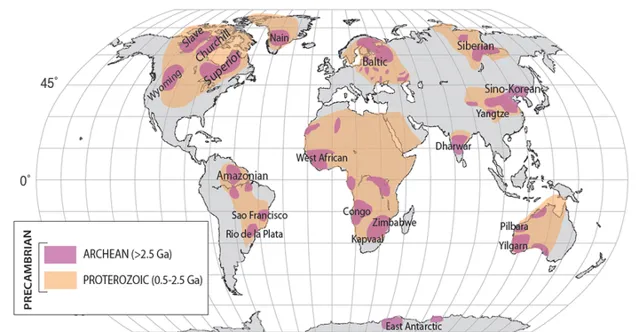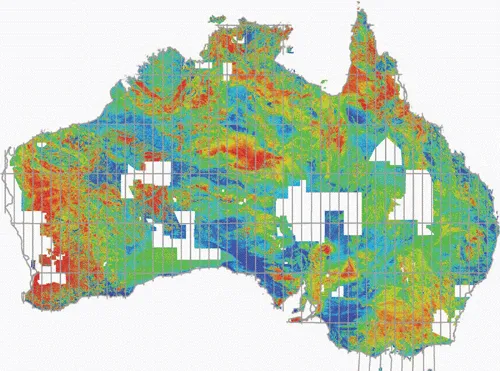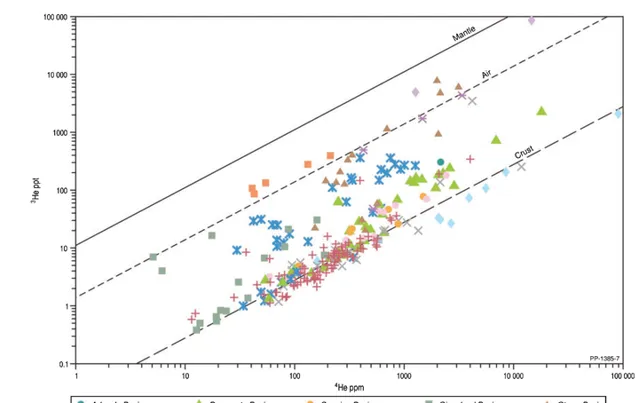美国多年以极低的价格出售氦,导致各国矿业公司毫无经济动力勘探氦储。
跟曾经中国的稀土储量占世界96%原因差不多,因为中国曾经以极低价格出售稀土,导致各国矿业公司毫无经济动力勘探稀土。
氦来源于放射性元素的α衰变,理论上天然辐射本底高的地方都有储藏氦的机会。
因为地球上的放射性元素来自于太阳系形成时的原始星云, 一般来说古老的大陆板块往往天然辐射本底偏高*,比如北美东北部。确实20世纪美国产出了世界上大部分的氦,但北美东北显然不是唯一古老的陆块,南部非洲和西非、东欧波罗的海、中西伯利亚、巴西高原亚马逊盆地、澳大利亚中西部、印度南部也是古老陆块 [1] [2] 。华北比较特别,克拉通已经发生破坏 [3] 。
* 反之不成立,不古老的陆地并不必然天然放射性低

一些已知的大陆天然放射性本底数据,灰色和白色为缺数据 [4] [5]


天然辐射高的区域都是有机会勘探到氦的,虽然不是一定有,但全世界这么多天然辐射高的区域,澳大利亚、哈萨克、加拿大有世界上最大的铀矿,巴西、澳大利亚、印度、土耳其有大型钍矿,为什么偏偏只有美国东部有氦?这听起来就不太对。
例如:早在1987年就已经清楚,澳大利亚某些地区的天然气中含有大量的氦 [6] [7] [8] ,但是因为氦提纯和储藏设施价格昂贵,无利可图,所以长期以来天然气中的氦都是被当作杂质排放的 [9] 。

而非洲和南美的勘探条件就更差,可能从来没有认真调查过。
随着氦气价格的上涨,一些公司也开始向这个方向投资,阿尔及利亚、俄罗斯、澳大利亚已经开始兴建氦提纯厂,把原来当作杂质和废气的氦提取出来 [9] [10] 。
参考
- ^ Irina M. Artemieva and Walter D. Mooney. Thermal thickness and evolution of Precambrian lithosphere: A global study. JOURNAL OF GEOPHYSICAL RESEARCH, VOL. 106, NO. B8, PAGES 16,387–16,414, AUGUST 10, 2001
- ^ Petrescu, Laura. (2017). Petrescu-L-2017-PhD-thesis. 10.13140/RG.2.2.27302.57929.
- ^ 朱日祥, 徐义刚. 西太平洋板块俯冲与华北克拉通破坏. 中国科学: 地球科学, 49卷, 9期: 1346-1356(2019)
- ^ Giorgia Cinelli, Tore Tollefsen, Peter Bossew, Valeria Gruber, Konstantins Bogucarskis, Luca De Felice, Marc De Cort. Digital version of the European Atlas of natural radiation. Journal of Environmental Radioactivity, Volume 196. 2019, Pages 240-252.
- ^ Brian Minty, Ross Franklin, Peter Milligan, Murray Richardson, John Wilford. The Radiometric Map of Australia. Exploration Geophysics 40(4) 325-333. 7 December 2009.
- ^ almer N and Ambrose GJ, 2012. Mt Kitty Prospect, Southern Amadeus Basin. In: Ambrose GJ and Scott J, (Editors, 2012). Proceedings of the Third Central Australian Basins Symposium, Alice Springs, 16-17 July 2012. pp 14.
- ^ Palmer N and Ambrose GJ, 2012. The Mt Kitty Prospect: Regional thrust belts in the southern Amadeus Basin host numerous wet gas and helium plays. Pesa News. pp 48-49.
- ^ McKay BA, 1987. Helium Resources and Developments in Australia. BMR Record 1987/22.
- ^ a b Christopher J. Boreham A D , Dianne S. Edwards A , Robert J. Poreda B , Thomas H. Darrah C , Ron Zhu A , Emmanuelle Grosjean A , Philip Main A , Kathryn Waltenberg A and Paul A. Henson. Helium in the Australian liquefied natural gas economy. The APPEA Journal 58(1) 209-237.
- ^ Michael C. Clarke, Duncan Seddon, Greg Ambrose. Helium: will it be the next mineral to boom in Australia? Ausimm Bulletin, December 2014.











